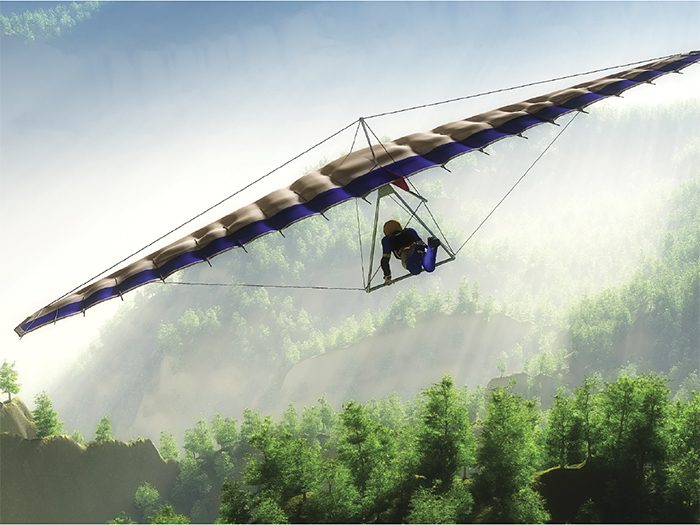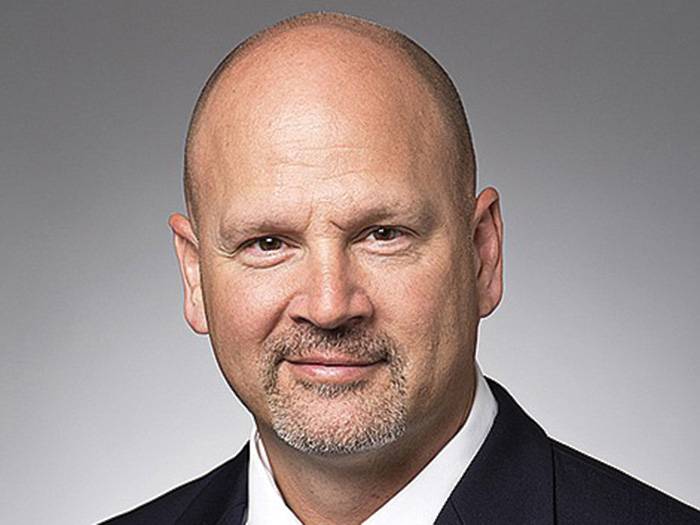2018 Vermont Report
A Perfect Landing

We live in a busy, hectic, noisy world. Many of us wish we could get away from the distractions and experience peace and tranquility. Some of us make it happen through meditation, running, art or camping. But for one group, shutting out the noise takes them to a whole new level — literally. They are members of the U.S. Hang Gliding and Paragliding Association.
Hang gliding and paragliding have been called the purest form of flying. Enthusiasts say that without a motor — just the glider, one’s body and the wind — one experiences a thrill, a sense of peace and a oneness with nature.
“It’s a feeling like no other feeling in the world,” said Tim Herr, secretary and risk management officer, Recreation Risk Retention Group Inc., (RRRG).
“To take flight is a surreal experience, especially the first time you do it. It’s the purest form of flight. There’s no noise, no pollution and you feel like you are one with nature. I am up there with only the wind and sometimes a bird. To fly that close to a hawk or an eagle — they join you — it is incredible. When I am up there sometimes, I still can’t believe I am up there,” he said.
Herr started hang gliding in the 1980s and still recalls the early years when hang gliders were made from bamboo and plastic. Today, he runs the RRRG, which is the captive that allows the Association to be self-insured.
Back then, he said, “there were injuries due, at least in part, to subpar equipment and the lack of historical information on what works and what doesn’t when flying, landing and dealing with weather conditions.
“We realized we needed an association to help people stay safe.”
The U.S. Hang Gliding and Paragliding Association was born. The association developed best practices and standards that include location rating, education for members and instructor certification. They even worked with glider manufacturers to improve the safety and quality of gliders.
Another thing they realized they needed: liability insurance. They wanted coverage not only for their pilots, of course, but also coverage for spectators, vehicles on the ground and land and landowners. The landowners especially wanted to be named as insureds in the coverage. They were nice enough to let the gliders on their land, but understandably, they didn’t want the risk associated with the gliders should property damage or an injury (or worse) occur.
Becoming Self-Insured
Typically, the Federal Aviation Administration (FAA) regulates anything that flies. However, Herr said the FAA granted gliders an exemption from regulation with the caveat they were “on their own” in terms of safety and insurance. “Undertake at your own risk” became the unwritten regulation.
Even though there was no regulation mandating liability coverage, the gliders knew it was in everyone’s best interest to secure it. Protecting people first, then property and lastly, the up-and-coming sport’s reputation was paramount.
Previously, the association was able to obtain coverage through a well-respected international insurer. But when that longtime carrier was no longer able to write coverage for the association, the group knew it would need to be creative and resourceful in obtaining coverage.
It wasn’t easy.
“It was hard to find someone to write for this small- to mid-market,” Herr said. “But that changed when we went to Vermont to investigate captives. We looked at Vermont and learned about options and risk retention groups. It was the best option, especially since we needed to cover members in many different states across the country.”
The Vermont Captive Experience
In 2016, the Association formed a captive, domiciled in Vermont, that fell into a category known as risk retention groups (RRG).
A typical captive is formed when a single company funds itself and insures itself, benefitting from any derived revenue. With a risk retention group, many people, companies or organizations pool their money and insure themselves collectively. The key requirement is that they are like entities — in this case hang gliders and paragliders — but it could be schools, members of the same profession or like organizations.
The Association’s RRG is specifically for recreational organizations. RRRG’s purpose is to insure its members and protect free flight everywhere. They were joined in their RRG by The Foundation for Free Flight, The Professional Air Sports Association and several hang gliding and paragliding flight schools across the nation.
“We looked at Vermont and learned about options and risk retention groups. It was the best option, especially since we needed to cover members in many different states across the country.” — Tim Herr, secretary and risk management officer, Recreation Risk Retention Group Inc.
Vermont was a good fit for the Association. The state is filled with recreational opportunities and outdoors enthusiasts, so people appreciate the desire for a sport such as gliding.
The state of Vermont is also a leading domicile for captives. They’ve been hosting captives for more than 35 years as a global leader in captive insurance.
According to Sandy A. Bigglestone, director of captive insurance, Vermont Department of Financial Regulation, “Vermont is number one in gross written premium, number one in assets under management, and third in active captive insurance companies in the world.
“Vermont is home to 48 of the Fortune 100, and 18 of the companies that make up the Dow 30 have Vermont captives.”
But it was the ease of working with Vermont, their expertise and their staff’s experience that helped to make it a natural choice.
“Working with Vermont was wonderful,” Herr said. “They understand the small niche insurance market. The first meeting is always filled with trepidation, but we showed them our plans and they understood what we needed and wanted to do.”
The Association needed to raise capital to the tune of $3 million in just nine months, which they were able to do through a fundraising campaign and surplus loans from members. With the funding secured, they moved on to reinsurance and other issues and were able to get RRRG off the ground by 2016.
RRRG now has 29 member groups covering the flights of more than 9,000 USHPA members, 83 USHPA chapters, and more than 30,000 hang gliding and paragliding students annually.
“In Vermont, we had the support we needed,” Herr said. “They have a deep history with captives. They’ve done this before, and it is not a drawn-out process.”
Expert Advice
During the process, the Vermont captive experts offered the Association some crucial advice that has since enhanced member safety as well as the Association’s ability to self-insure: Create an active risk management program.
The Association was diligent in putting a risk management program together.
Today, every chapter of the Association must write and submit with its membership application a plan detailing how it will manage risk.
This must be completed and reviewed before any organization is granted entrée to the Association or can obtain liability insurance through the RRRG.
“We have a laundry list of things they must do,” Herr said.
That list includes things such as: devise a plan to protect spectators, conduct pilot training on-site, note wind and geographic dangers and publish site guides that detail site conditions and how to safely fly at their locations.
Additionally, the Association developed safety features accessible on their website, including two pre-flight safety apps available as interactive PDFs or on iTunes.
Learning Opportunities
Leaders in captive organizations say education is an important part of the process. Understanding legislation and regulations in each domicile helps find the right fit.
Organizations such as the Vermont Captive Insurance Association (VCIA) offer online education and training for industry newcomers and seasoned professionals. Topics ranging from “the advantages of captives” to tax implications are covered, as well as accounting and auditing for captives.
Additionally, they provide a “Captive Service Directory,” a list of VCIA members who provide services to the captive industry, such as consultants, attorneys, managers, brokers, underwriters and more.
The National Risk Retention Association, a nonprofit trade organization dedicated to protecting the rights of owner insureds, offers resources for their members, as well as an annual conference.
Its executive director, Joe Deems, said there are many good states that are domiciles and clearly Vermont is among them.
“Vermont built a good department. They were one of the first states to become a domicile. They are diligent, and they have a good staff with bright people. If Vermont approves you to be an RRG, then you have the necessary nuts and bolts to make it work,” he said. &









